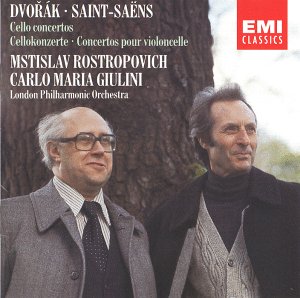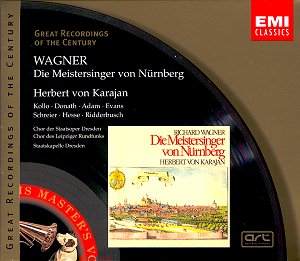 Composer: Antonín Dvořák (1841-1904)
Composer: Antonín Dvořák (1841-1904)
Work: Cello Concerto in B minor, Op. 104, B191
Composer: Camille Saint-Saëns (1835-1921)
Work: Cello Concerto No. 1 in A minor, Op. 33, Op. 33
Performers: Mstislav Rostropovich (cello), London Philharmonic Orchestra, Carlo Maria Giulini
Recording: Recorded in No. 1 Studio, Abbey Road on April 29th-30th and May 1st, 1977
Label: EMI GREAT RECORDINGS OF THE CENTURY CDM5 67593-2
Duration: 62:39
In this esteemed recording of Dvořák’s Cello Concerto in B minor and Saint-Saëns’ Cello Concerto No. 1 in A minor, Mstislav Rostropovich emerges as a pillar of interpretative mastery, his artistry reflecting both the emotional depth and technical demands of these substantial works. Under the baton of Carlo Maria Giulini, Rostropovich’s performance becomes a profound dialogue between soloist and orchestra, each phrase imbued with an understanding that transcends the mere notes on the page.
Dvořák’s Cello Concerto, completed in 1894, is a cornerstone of the cello repertoire, celebrated for its lyrical beauty and dramatic scope. In this recording, Rostropovich’s approach is characterized by a nuanced blend of passion and restraint, allowing the music’s inherent nostalgia to breathe. The slow movement, marked “Adagio ma non troppo,” is particularly mesmerizing; Rostropovich’s tone here is rich and haunting, with a sensitivity that captures the work’s melancholic essence. His ability to shape phrases with subtle inflections and dynamic shading is exceptional, demonstrating a deep connection to Dvořák’s thematic material.
Giulini’s orchestral support is commendable, with the London Philharmonic Orchestra providing a luminous backdrop that enhances the cello’s voice. The textures are skillfully balanced, highlighting the contributions of the woodwinds and the luminous horn solo that emerges in the first movement exposition, which serves as a reminder of the concerto’s orchestral richness.
However, while the performance is undeniably compelling, one must address the recording quality. The engineering, typical of the era, exhibits a warmth that, while inviting, occasionally muddies the lower registers. This can detract from the clarity of intricate passages, such as the bassoon countermelody at 6’50 in the finale. Despite this, the overall sonic landscape remains engaging, and the vibrant orchestration shines through, particularly in the energetic third movement, where Rostropovich’s virtuosic display is matched by the orchestra’s spirited response.
The coupling of Saint-Saëns’ Cello Concerto No. 1 is a judicious choice, reflecting Rostropovich’s passion for this work, which he famously premiered in his youth. The concerto, often regarded as a technical tour de force, is given a fresh interpretative lens here. The opening orchestral chord followed by the soloist’s flourish sets a lively tone, with Rostropovich navigating the Allegro con moto with both elegance and flair. His phrasing is buoyant, perfectly complementing the playful spirit of the music.
Saint-Saëns’ work, while perhaps overshadowed by its more celebrated counterparts, offers a rich tapestry of emotional and technical challenges. Rostropovich’s performance showcases a delightful interplay of light and shade, particularly in the contrasting moods of the finale, where his deft handling of rapid passages reveals both technical prowess and interpretative insight.
In the historical context, both concertos reflect pivotal moments in the evolution of cello music, with Dvořák’s work embodying the late Romantic spirit and Saint-Saëns’ piece bridging the gap between classical form and the burgeoning expressiveness of the 20th century. The significance of this recording lies not only in the performances themselves but also in the way they illuminate the ongoing dialogue between tradition and individual expression.
In conclusion, this recording stands as a testament to Rostropovich’s extraordinary artistry and the synergy of his partnership with Giulini and the London Philharmonic. It is an enriching listening experience, marrying technical brilliance with profound emotional insight, despite minor reservations regarding the recording quality. For both connoisseurs and newcomers, this disc offers an invaluable glimpse into the heart of the cello repertoire, affirming Rostropovich’s legacy as one of the great interpreters of these masterworks.

